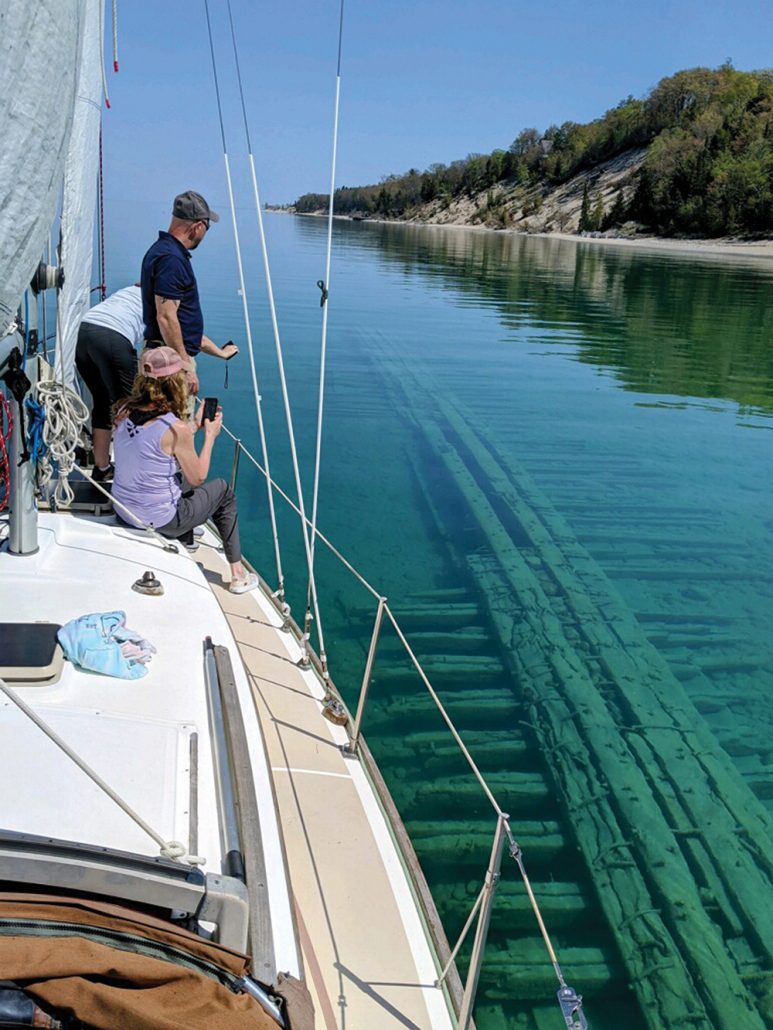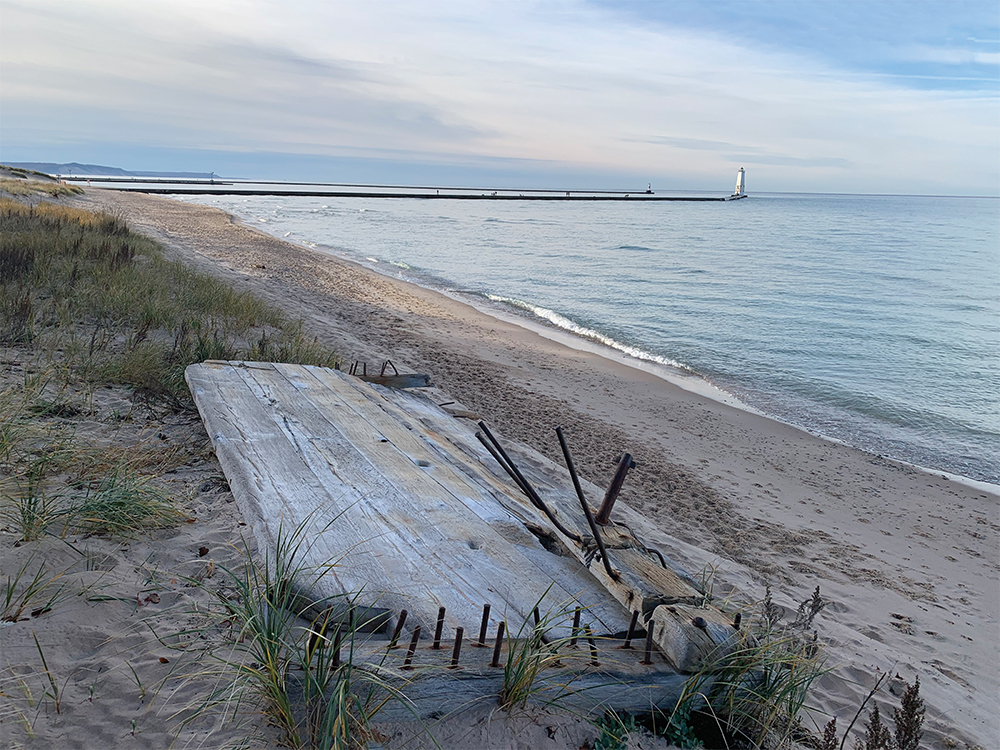Hazard, tourist attraction, or priceless historical artifact?
By Jed Jaworski
Current Contributor
In the fall of 1908, a captain and his five-person crew were aboard the schooner Ida, bound from Thompson in Michigan’s Upper Peninsula to Chicago. A cargo of lumber filled the holds of the three-masted schooner, as well as being stacked high on the open decks.
At the time, the Ida was 41 years old, nearly twice the average retirement age of a wooden sailing ship, but she had thus far been lucky most of her life—always avoiding shipwreck and somehow finding one more paying cargo to make the aged vessel worth her keep.
The profits from a successful late-season trip were always welcomed, and for this particular voyage, it was thought, like always, that the Ida would pull through the late-fall storms to bring her cargo and crew safely to port. However that fall, a late September gale and the aging ship’s timbers would change that assumption forever—the Ida would not arrive in Chicago but rather find herself driven ashore at Frankfort, where storms broke the noble ship asunder and scattered her beneath the sand and waves.
Now—154 years after the ship first appeared on the launch ways in Milwaukee, Wisconsin—a piece of what is likely the ship has reappeared on the Frankfort Public Beach.
A Traveling Shipwreck
Recent record-high water levels and severe storms have unearthed a number of shipwrecks and shipwreck artifacts along the Great Lakes coastline, and the Frankfort coast is no exception. (Editor’s Note: See The Betsie Current’s “Unburied Treasure” article by Jed Jaworski from December 2019 in our online archives.)
What is exceptional is that this piece has likely traveled two miles down the coast from the Ida’s wreck site, made a few cameo appearances from decade to decade along the way, and finally landed smack dab in the middle of Frankfort’s Municipal swimming beach. Having been declared a “public safety hazard” by City officials, it was hauled with mechanical equipment out of the water and up onto the beach below the foot of Nipissing Street, where it sits, further ravaged by the elements.
The question now is—what to do with the unique artifact?
What To Do
The City of Frankfort dutifully informed Michigan’s State Archeologist, on staff with the State Historic Preservation Office, of the discovery and the removal of the artifact from the water to the upper beach.
In order to inform any decision about the future of the relic, a determination of historical significance must be made. What is the piece? What is its condition? Can it be attributed to the Ida with certainty? Is it eligible for State or Federal protections? Should it be preserved and interpreted; if so, for how long, where, and who will pay for that?
The future of the artifact—and many like it—are fraught with peril and uncertainty, as protections are few and relocation and preservation efforts are often expensive.
What Is Known
When the Ida sprung a leak, capsized, and became waterlogged about 10 miles off Point Betsie, the captain ordered the ship be abandoned and the crew took to the lifeboat, safely making shore. Though filled with water, the Ida’s cargo of lumber inside the hold kept the vessel afloat. She drifted before the storm and went ashore, hitting the sandbar off the Congregational Summer Assembly (CSA) beach. At that time, the CSA was primarily a tent camp, so having a shipload of lumber dumped on their beach is said to have been of good fortune and fodder for some of the first cabins built there.
The ship quickly broke up; what was not salvaged sank beneath the waves or sandy shores. The Northwest Michigan Maritime Museum was based in Frankfort from 1981 to 1991. During that time, staff monitored the Ida wreck site, along with others in the area, and documented that the debris field from the wreck traveled south and additionally that large sections of wreck can migrate great distances in single storm events.
In 1988, a partially uncovered piece of wreck was reported on the far north end of the Frankfort beach. The Maritime Museum staff—utilizing a backhoe from the City of Frankfort—carefully excavated enough of the buried piece to identify it as a “centerboard trunk and centerboard.”
A centerboard is an integral device in the sailing ship’s hull that, in this case, is made of white oak and iron. The centerboard is lowered when at sea, stabilizing the ship and allowing it to sail windward. When the vessel needs to enter shallow harbors, the centerboard is winched up through the hull into its watertight “trunk.”
Though the centerboard that was found on the Frankfort beach could be from another ship, when it recently became fully uncovered, it was able to be measured at 20 feet long by eight feet wide, making it a perfect fit for the 120-foot-long Ida.

What Is Its Value
Value is in the eye of the beholder. To some, the artifact would make a great beach fire or a table top; to others, it is a priceless piece of material history to be studied and marveled at—a part of the area’s maritime legacy of shipwrecks and lifesaving.
With a State Underwater Preserve, two historic Lifesaving Stations, and two Coast Guard Stations still standing here in the Frankfort-Elberta-Betsie Bay area, it is hard to deny that perspective.
At some point in history, when partially exposed, someone clearly “valued” this centerboard enough to take a hatchet to it in an attempt to salvage some of it—the crude ax marks are still showing. And while a centerboard was a common feature on a common type of schooner once upon a time, it is certainly an uncommon and rare thing now. To view an intact centerboard, one would likely have to make a deep, cold dive to a submerged wreck, since there are no Great Lakes schooners surviving afloat.
Even the white oak planks are a wonder, since there are few trees living that could provide such straight-grained, wide, thick, and sturdy boards. It is still apparent that the leading edge of the centerboard was planned narrow, to better cut the water. James Roth, a blacksmith from Hell Creek Forge, recently marveled at the piece, commenting on the hand-forged work and skill of assembly.
The Future
State Archeologist Wayne Lusardi tells The Betsie Current that—when notified by the City of Frankfort—he responded by visiting the site and documenting the artifact. He advised the City to rebury the centerboard immediately to protect it, or to submit a proposal for some other disposition; nearly a year later, no indication of action or plan has been provided to him.
“The city is at a place where it needs to determine the best long-term plan for the artifact—take the archaeologist’s advice and bury it and GPS it so that people can find it, or do we preserve it and put it on display to tell a story? The obstacle with that is where do we put it?” says Josh Mills, the city superintendent of Frankfort. “Perhaps we need to have a public discussion to decide what happens next. I’d like it to be a happy ending to preserve our maritime history.”
“A shipwreck found is a shipwreck lost” is an oft heard saying amongst preservationists, however, there are many viable options for preservation.
Returning the artifact to Lake Michigan is one option, but there is no certainty of preservation with the turbulent coastal dynamics. While it is true that “you can’t save everything,” some things are worth holding onto—if only for a time.
To give a recent case in point, on the other side of Lake Michigan, in Sheboygan, Wisconsin, a shipwreck was discovered to be blocking a harbor-expansion project. The wreck was removed, but in a visionary compromise measure to avoid its destruction, it was reassembled ashore as an educational exhibit. People marvel at being able to walk through a shipwreck safely with their kids, like you would be diving on it in the depths. The wreck could not be cost-effectively preserved forever, but the 20 or 30 years that it will survive as an outdoor park exhibit seems well worth the effort to most.
Wayne Lusardi remarked that the centerboard on the Frankfort beach is, fortunately, small enough to apply preservatives and place under an awning to protect it from rot-inducing moisture—and it would make a compelling exhibit, if properly interpreted on the waterfront.
Frankfort’s harbor provides access to the 272-square-mile “Manitou Passage State Underwater Preserve,” which begins just north of Point Betsie and contains more than 70 recorded shipwrecks. At present, there is no public interpretation in Frankfort about the preserve, our shipwreck coast, or the region’s legacy of daring rescues. An exhibit could be a valuable contribution to preserving both our community’s seafaring history and promoting our tourism economy.
“The question becomes how do we pay for something like that? And where does it go?” says Josh Mills, city superintendent, who indicates that there have been discussions with the Benzie Area Historical Society and Museum. “Perhaps a benefactor reads this piece and decides to donate.”
The artifact could also potentially be placed indoors in a museum’s collection. For instance, the Ida’s transom—the back end of a ship—was already recovered with Federal assistance to save it from being destroyed during a storm in the 1980s, and it is currently in National Park Service indoor storage.
Weighing these kinds of options are good exercises for a community—deciding what is valued, what should be held onto, and attempting to do that in a rational and respectful way.
The Elberta Life Saving Station was saved, but 16 other National Historic Landmark structures—including the last ferry—were destroyed or sent packing. Point Betsie Lighthouse was saved, but long gone are the colorful remnants of the area’s great commercial fishery, which the village of Leland has preserved and capitalized upon with Fishtown.
As Walter Cronkite stated in his narration of “Maritime America, a Legacy at Risk,” produced by The National Trust for Historic Preservation: “To accept the legacy of those that came before us is to understand more about ourselves, and the world left to our care.”
Hopefully this remarkable piece of material history—now dragged up and soon to rot on the beach—will be accepted and properly cared for as part of our legacy.
“Until we determine the longer-term preservation associated with this archeological artifact, before winter, the City is going to move it away from the shoreline and properly bury it to temporarily preserve it, until the community makes a determination on its end use,” Mills says, in response to this article.
Featured Photo Caption: The schooner Ida was built in 1867, wrecked in 1908, and this centerboard piece of the wreck was first identified in the late 1980s. The piece finally washed up on the Frankfort municipal beach in the fall of 2020. After consulting with Michigan’s State Archeologist, there still is no consensus on what to do with this maritime history in the long term. In this photo, the exposed centerboard is shown with proximity to Frankfort pier and lighthouse in the background. Photo by Jordan Bates.





Very well written article. This is an important issue and I hope that this amazing artifact can be preserved for future generations.